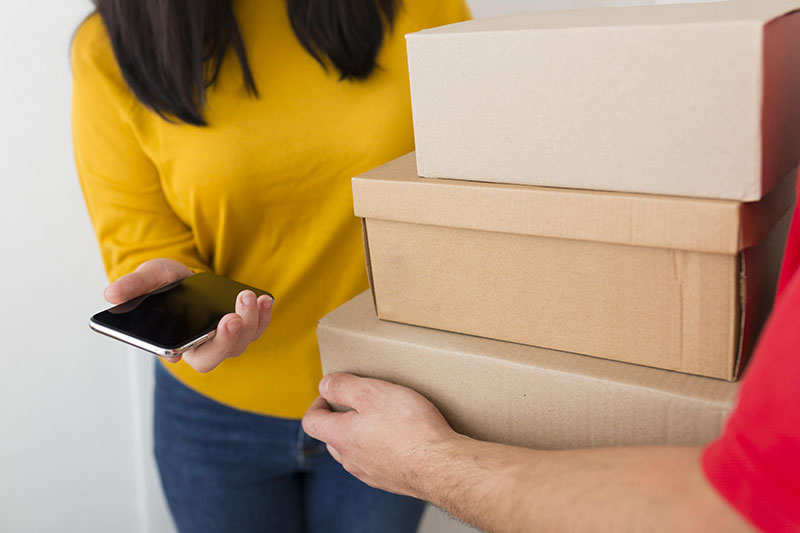Online shipping: how e-commerce delivery works
Building a robust online shipping process is essential for efficient delivery of orders in e-commerce.
As the main objective of an online business is to send products to end customers, several practices must be followed to be successful in this operation. Keep reading to know more!

How does online shipping work?
The online shipping process involves from receiving the order in the online store until preparation for the last mile delivery.
In a simplified way, it refers to the series of activities that carry out the movement of goods from one point to another.
One well-managed delivery system influences how consumers perceive a business and impacts customer satisfaction.
If you run an e-commerce, it is essential to know and understand how online shipping works.
Basically, we have three main activities:
- Pre-boarding: Involves receiving the order and registering shipping, separation, packaging and product labeling.
- Shipping and delivery: This is the second step in the online shipping process, which involves dispatching the order to the carrier/delivery man for the actual delivery of the goods to the customer. This phase also involves tracking the package as it moves towards its destination.
- Post-delivery: Happens when the customer receives the order and confirms delivery. The post-shipment process deals with returns and exchanges, provides customer support, and manages lost or damaged packages.
Step-by-step of an online shipping process
For better understanding, we have divided the online shipping process in e-commerce into six simple steps:
Order Processing
This is a term for a set of activities necessary to fulfill the customer’s request.
Each purchase is linked to a specific order and a tracking ID of the item to be delivered.
Different teams have different tasks to perform in order processing. Typically, the production and logistics team updates inventory, closes the purchase order, and assigns tasks to the packaging and delivery team.
Sorting and Packaging
The next step is to separate the items of the order and pack them appropriately for transportation.
The packaging has a dual purpose; firstly, it prevents the item from being damaged and secondly, helps create brand value.
Some of the standard options include boxes, packages, envelopes, etc. The choice is made according to the type and characteristics of the item to be transported.
Labeling
The products are labeled with customer information such as address, contact number, order number, tracking number, etc.
Delivery
It is the most important step in the entire online shipping process.
To be successful, e-commerce companies need an agile and well-executed delivery process, which is why many enter into partnerships with apps specialized in delivering products/services, such as Delivery365.
With expertise in fast order delivery, we have all the technology and structure necessary to carry out the entire shipping process with agility and precision.
Tracking
The tracking number helps the supplier and buyer to stay updated about the delivery status.
Using this number, they can track the package’s journey through the website or app.
This step is crucial to ensure customer satisfaction and optimal resource utilization.
Through a tracking code, customers can get real-time updates on the status of your packages without needing to contact the support team.
Returns
Online submission also involves reverse logistics, which refers to the order exchange or return process.
This can happen for a number of reasons, such as damage caused during transportation, quality problems or customer dissatisfaction.
After the customer requests the return, the delivery man collects and sends it back to the retailer.
Based on the return terms and conditions, the refund will be processed by the retailer.
Types of shipping for e-commerce
Shipping calculation in e-commerce is done according to several factors, including the type of product, weight, dimensions, destination, type of delivery service chosen and even the specific policy of the transport company or e-commerce platform.
To make this calculation, many stores provide an online calculator on their checkout pages, so the customer knows exactly how much they will pay.
It is recommended that companies that work with online shipping provide different delivery options for their customers. The most common are:
- Free: Many online stores offer free shipping as a promotion to attract customers. Typically, this is conditional on a minimum purchase amount or certain specific products.
- Express: This type of shipping is faster. It is ideal for customers who need to receive their products quickly, such as in urgent cases.
- Economic: It is a cheaper but slower option. It is suitable for customers who are willing to wait longer to save on shipping costs.
- Same-Day Delivery: Some companies offer same-day or next-day delivery to certain regions, using courier services or specialized logistics.
Choosing an online shipping method depends on several factors, including the customer’s budget, delivery urgency, geographic location and the e-commerce’s shipping policy.
Offering varied options can improve the customer experience and increase sales by allowing each shopper to choose the option that best meets their needs.
Optimize your online shipping process with Delivery365

The growing popularity of digital platforms has led to the rapid development of e-commerce.
With innovative shipping technology and techniques arriving almost every day, logistics becomes a fundamental ally of this line of business.
Delivery365 app enables the creation of your own e-commerce, offering tracking technology, shipping calculation, ways to receive payment online and direct connection with a base of hundreds of delivery people.
Simply register your business on our app to have your own online store and, best of all, connected to couriers ready to deliver your products.
To learn more, visit our website, learn about our services and guarantee the better delivery service to your customer.


